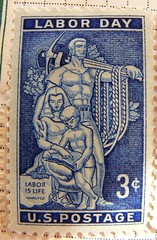 Image by Jo Peattie via Flickr
Image by Jo Peattie via Flickr
Although for most of us it's just another day off or an extended weekend, Labor Day is an excellent time to reflect on those men and women (and children!) who came before us, helped build this country, and whose lives continue to reverberate in this new century.
Think about it in today's context. Even though today's economy is said to be in recovery, according to CBS News, "the president will be in Detroit this Labor Day. Unemployment there is about 14% - that's five points above the national average." Furthermore, "[u]nemployment for African Americans is the highest it has been in 27 years."
Perhaps now, more than ever, it would be instructive to closely examine the nature of work in the USA. Toward that end, curators at The National Archives have designed some wonderful virtual exhibitions that pay tribute to American laborers and many others. From their website:
Imagine working in a coal mine.
Or in a steel mill.
Or at a telephone switchboard.
Work and workplaces have gone through enormous transformations between the mid 19th and late 20th centuries. You can view these changes through photographs held by the National Archives and Records Administration.
My own contribution was to download a video from their site, and make it into something new and (hopefully) more compelling. Although the video was completely silent, I changed the work by simply adding a soundtrack. This video now features a soundtrack by Thievery Corporation, who remixed a song from the Doors, a band popular many years ago. See the parallels?
Hopefully you'll understand this "secret" message: don't be afraid to respond to media that usually is intended to be one-way. The internet and computer technology has made it possible for anyone to become a creator and to "talk back" to media. "Work" such as this can be very fulfilling and meaningful. Hopefully, this small "labor of love" will encourage you to think about today as more than "Just Another Labor Day".
Lastly, since we are starting our course with a "Stories and Histories" theme, what narrative do you see being weaved through this video?
